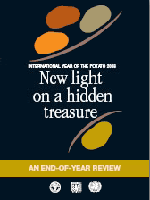15 December 2008: Marking the end of the 2008 International Year of the Potato (IYP), the UN Food and Agriculture Organization (FAO), in collaboration with the International Potato Center (CIP), released a book entitled: “International Year of the Potato: New Light on a Hidden Treasure.” The book reviews IYP achievements, underscores its essential message that […]

15 December 2008: Marking the end of the 2008 International Year of the Potato (IYP), the UN Food and Agriculture Organization (FAO), in collaboration with the International Potato Center (CIP), released a book entitled: “International Year of the Potato: New Light on a Hidden Treasure.”
The book reviews IYP achievements, underscores its essential message
that the potato is a vital part of the global food system, describes
the history of the potato, and includes the most recent FAO statistics
on potato consumption and production. The book also summarizes IYP
conferences and workshops around the world, many of which stressed the
impacts of climate change on potato production and associated
challenges for breeding new potato varieties that are adapted to
climate change.
The book includes an interview with Marco Bindi, University of
Florence, Italy, and lead author of the Fourth Assessment Report of the
Intergovernmental Panel on Climate Change, on the effects of climate
change on global potato production. Bindi states that, while increases
in atmospheric carbon dioxide levels can significantly increase yields,
these gains will be offset by the negative impacts of rising
temperatures, water scarcity due to changing precipitation patterns,
and higher pressures through pests such as late blight in certain
regions. Regarding adaptation options, Bindi noted: anticipating
planting dates; using improved varieties; increasing soil water supply
in dry regions; and shifting potato production to higher altitudes and
latitudes as temperatures rise. The book’s conclusions stress, among
other issues, the need to conserve genetic diversity as basis for
breeding new varieties adapted to climate change. [The Book] [IYP Website] [CIP Website]